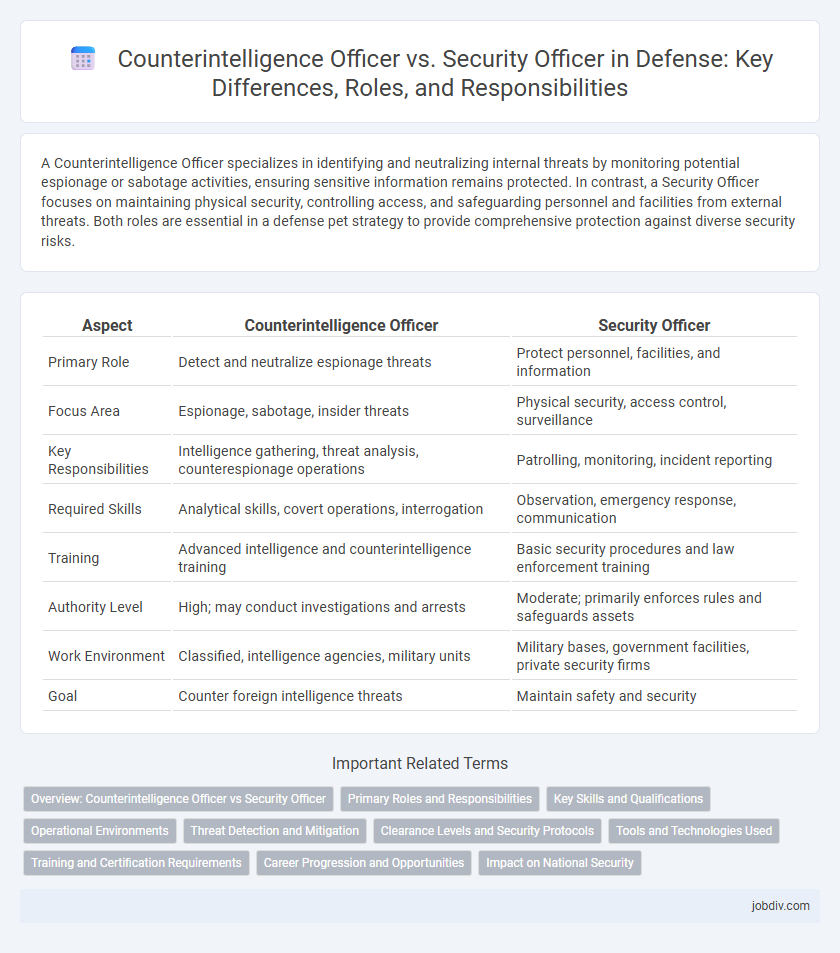A Counterintelligence Officer specializes in identifying and neutralizing internal threats by monitoring potential espionage or sabotage activities, ensuring sensitive information remains protected. In contrast, a Security Officer focuses on maintaining physical security, controlling access, and safeguarding personnel and facilities from external threats. Both roles are essential in a defense pet strategy to provide comprehensive protection against diverse security risks.
Table of Comparison
| Aspect | Counterintelligence Officer | Security Officer |
|---|---|---|
| Primary Role | Detect and neutralize espionage threats | Protect personnel, facilities, and information |
| Focus Area | Espionage, sabotage, insider threats | Physical security, access control, surveillance |
| Key Responsibilities | Intelligence gathering, threat analysis, counterespionage operations | Patrolling, monitoring, incident reporting |
| Required Skills | Analytical skills, covert operations, interrogation | Observation, emergency response, communication |
| Training | Advanced intelligence and counterintelligence training | Basic security procedures and law enforcement training |
| Authority Level | High; may conduct investigations and arrests | Moderate; primarily enforces rules and safeguards assets |
| Work Environment | Classified, intelligence agencies, military units | Military bases, government facilities, private security firms |
| Goal | Counter foreign intelligence threats | Maintain safety and security |
Overview: Counterintelligence Officer vs Security Officer
Counterintelligence Officers specialize in identifying and countering espionage, sabotage, and intelligence threats against national security by conducting investigations, surveillance, and analysis. Security Officers primarily focus on protecting physical assets, personnel, and information systems through access control, patrols, and enforcing security protocols. Both roles are vital in defense, with Counterintelligence Officers addressing internal and external intelligence threats, while Security Officers ensure overall facility and operational security.
Primary Roles and Responsibilities
Counterintelligence Officers primarily focus on identifying, preventing, and countering espionage, sabotage, and intelligence threats posed by foreign entities to safeguard national security. Security Officers are responsible for protecting personnel, facilities, and classified information through access control, surveillance, and enforcing security protocols. Both roles are crucial in maintaining organizational security, with Counterintelligence Officers emphasizing threat analysis and covert operations, while Security Officers concentrate on physical security and compliance enforcement.
Key Skills and Qualifications
Counterintelligence Officers require advanced analytical skills, proficiency in intelligence gathering, and expertise in detecting and neutralizing espionage threats to protect national security. Security Officers focus on physical security measures, risk assessment, and access control, with qualifications often including certifications in security management and emergency response. Both roles demand strong communication abilities and a thorough understanding of security protocols, but Counterintelligence Officers emphasize covert operations and intelligence analysis, while Security Officers prioritize safeguarding personnel and facilities.
Operational Environments
Counterintelligence Officers operate primarily in high-threat, classified, and clandestine environments where detecting and neutralizing espionage, sabotage, and insider threats is critical. Security Officers focus on securing physical assets, personnel, and facilities in more general operational settings, ensuring compliance with security protocols and mitigating unauthorized access. The complexity of Counterintelligence operations demands advanced analytical skills and covert methods, while Security Officers emphasize visible deterrence and access control measures across varied operational environments.
Threat Detection and Mitigation
Counterintelligence Officers specialize in identifying and neutralizing espionage threats by analyzing intelligence data and conducting covert investigations, thereby preventing adversaries from exploiting sensitive information. Security Officers focus on safeguarding physical assets and personnel through access control, surveillance, and immediate incident response to deter potential intrusions. Both roles collaborate to strengthen organizational resilience by integrating threat detection technology and maintaining comprehensive security protocols.
Clearance Levels and Security Protocols
Counterintelligence Officers typically hold higher clearance levels such as Top Secret or Sensitive Compartmented Information (SCI) due to their involvement in identifying and neutralizing espionage threats. Security Officers often operate with Secret or Confidential clearances, focusing on enforcing physical security protocols and safeguarding personnel and facilities. Both roles require adherence to stringent security protocols, but Counterintelligence Officers engage in more complex threat analysis and intelligence safeguarding measures.
Tools and Technologies Used
Counterintelligence Officers employ advanced surveillance technologies, signal intercept systems, and cyber forensic tools to detect and neutralize espionage threats. Security Officers utilize access control systems, intrusion detection sensors, and video monitoring platforms to safeguard physical assets and personnel. Both roles increasingly integrate artificial intelligence-driven analytics and biometric identification technologies to enhance threat assessment and response efficiency.
Training and Certification Requirements
Counterintelligence Officers undergo specialized training in espionage detection, threat analysis, and intelligence gathering, often requiring certifications such as the Certified Counterintelligence Professional (CCIP) or equivalent government credentials. Security Officers typically complete certifications like the Certified Protection Professional (CPP) or Physical Security Professional (PSP), focusing on physical security measures, access control, and emergency response. The rigorous and intelligence-specific training of Counterintelligence Officers distinguishes their role from the broader, security-focused education of Security Officers.
Career Progression and Opportunities
Counterintelligence Officers typically advance through specialized roles in intelligence analysis, surveillance, and threat assessment, leading to high-level positions within federal agencies such as the FBI or CIA. Security Officers often progress through supervisory roles managing physical security operations and compliance, with opportunities to transition into corporate security management or law enforcement leadership. Career growth for Counterintelligence Officers is driven by expertise in covert operations and national security, while Security Officers benefit from experience in risk management and facility protection strategies.
Impact on National Security
Counterintelligence Officers play a critical role in identifying, preventing, and neutralizing espionage threats, directly protecting national secrets and intelligence assets from foreign adversaries. Security Officers focus on safeguarding physical and information assets, ensuring secure environments that prevent unauthorized access and potential sabotage. Both roles significantly impact national security, with Counterintelligence Officers addressing covert threats and Security Officers maintaining comprehensive protection protocols.
Counterintelligence Officer vs Security Officer Infographic

 jobdiv.com
jobdiv.com